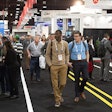“Animal rights activists take many approaches. There are environmental groups that would like to see the end of animal production and consumption,” said Hannah Thompson-Weeman, Animal Agriculture Alliance, during her presentation at the Poultry Market Intelligence Forum held during 2017 IPPE. Thompson-Weeman discussed the many external influences that affect the poultry industry in her presentation titled, “Securing the Poultry Industry’s Future: Responding to Animal Right Activist Threats.”
Thompson-Weeman mentioned that these groups of animal rights activists have several tactics for which producers should be aware. She remarked that recently activists have been attempting to gain access to farms following floods in North Carolina to obtain pictures or videos of animals in difficult conditions, attempting to present the animals’ situation as their normal existence. The people visit or trespass on farms with no concept of biosecurity. They also invest in youth, giving talks against animal production and meat consumption in high schools and colleges, in addition to advocating to religion to present their points of view.
In his presentation on “Performance Trends for the Poultry and Egg Industry,” Mike Donohue, Agri Stats, said that in 2016 broiler farmers gave up some of the tools used in production to appease customers, restaurants and the retail market. Donohue stated that the challenges for 2017 are the same, except that production gains will be reduced due to changes in medication programs. He also remarked that poultry genetic companies keep improving the performance of broilers over time.
“Among the challenges for 2016 was avian influenza, the loss of export markets and the value of leg quarters. Production gains were reduced due to changes in medication programs. We are enjoying relief in feed ingredient costs, but the future direction of production costs remains uncertain. Ethanol is not going away,” commented Donohue.
Dr. Paul Aho, Poultry Perspectives, gave an overview of “Domestic and Global Drivers for 2017.” He discussed the poultry industry’s position in the commodity cycle and interest rate cycle, as well as trends in median household income and projections for growth.
Aho predicted a shift from corn production to soybean production. He mentioned that corn production is stable in the U.S. and overseas, and there is not a huge incentive to grow. Aho commented that soybean meal has not reached its highest point yet, and production is rapidly increasing in Argentina, Paraguay, Uruguay and the U.S. Aho predicted that grain prices will rise in 2018-2019.
Aho expects pork production to increase by 5 percent and beef production by 3 percent. There will be higher quantities of meat in the market, though he “predicts no problem if economic growth continues.” Aho further observed that poultry production volume in the U.S. can continue to grow by approximately 4 percent, notwithstanding any unforeseen events.
Aho also provided a forecast on the world economy. He speculated about the trade relations with Mexico and the rising U.S. dollar against the Mexican peso. Aho stated that Mexico is the first largest buyer of U.S. chicken leg quarters, purchasing 25 percent of all leg quarters. The next largest buyer is Cuba. Aho posed the question, “Will the U.S. have smooth diplomatic relations with Mexico and Cuba this year?”















